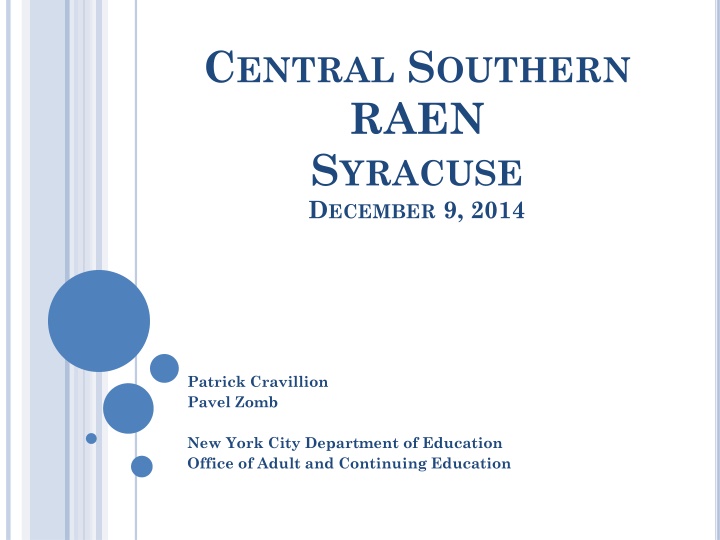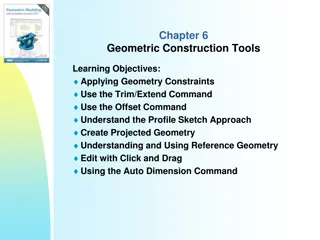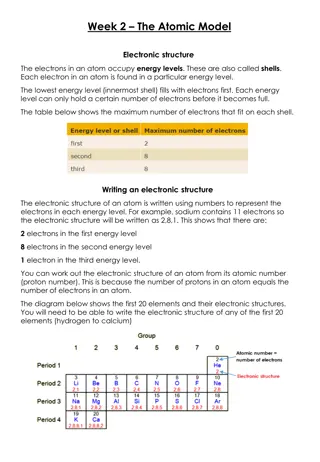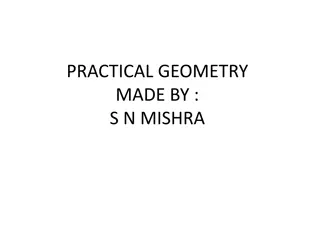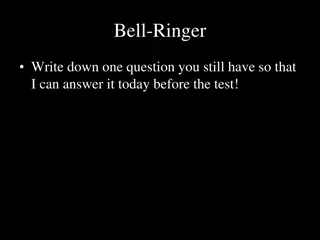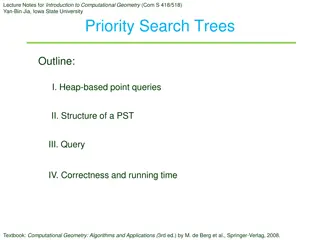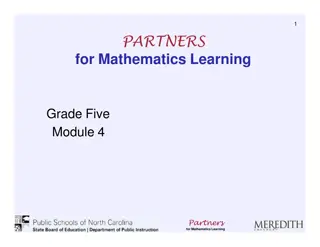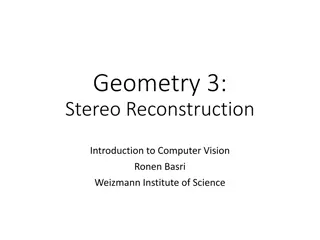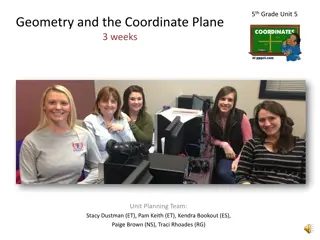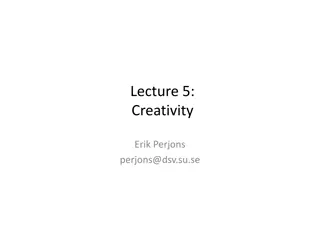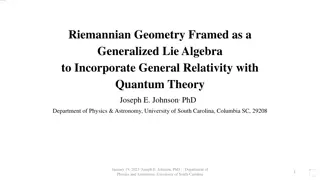Levels of Thinking in Geometry: Van Hiele Model Explained
In the Van Hiele Model, students progress through different levels of geometric thinking, starting from visual recognition to abstract understanding and formal deduction. This model outlines levels such as the Visual Level, Descriptive/Analytic Level, Abstract/Relational Level, Formal Deduction, and Mathematical Rigor, each building upon the previous one to deepen geometrical understanding. The characteristics and skills associated with each level are crucial for developing strong geometric reasoning skills in students.
Uploaded on Feb 18, 2025 | 0 Views
Download Presentation

Please find below an Image/Link to download the presentation.
The content on the website is provided AS IS for your information and personal use only. It may not be sold, licensed, or shared on other websites without obtaining consent from the author.If you encounter any issues during the download, it is possible that the publisher has removed the file from their server.
You are allowed to download the files provided on this website for personal or commercial use, subject to the condition that they are used lawfully. All files are the property of their respective owners.
The content on the website is provided AS IS for your information and personal use only. It may not be sold, licensed, or shared on other websites without obtaining consent from the author.
E N D
Presentation Transcript
CENTRAL SOUTHERN RAEN SYRACUSE DECEMBER 9, 2014 Patrick Cravillion Pavel Zomb New York City Department of Education Office of Adult and Continuing Education
VAN HIELE MODEL Levels of thinking in Geometry
LEVELSOF THINKINGIN GEOMETRY Visual Level Descriptive Level Relational Level Deductive Level Rigor 3
VAN HIELE MODEL Level 1: Visual level Students at this level recognize figures by their appearance. For example they may say that the shape on the left below is a square and the shape on the right is a diamond ...."because it looks like a....
VAN HIELE MODEL Level 2: Descriptive/Analytic Students at this level recognize/analyze figures by their properties or components. For example, students will describe figures below as squares because they both have 4 sides, 4 right angles, opposite sides equal....and as many other properties as they know about squares.
VAN HIELE MODEL Level 3: Abstract / Relational Students at this level can distinguish between necessary and sufficient conditions for a concept; they can also form abstract definitions, and classify figures by elaborating on their interrelationships. For example, a student at this level may define a square as a rectangle with consecutive sides congruent
VAN HIELE MODEL Level 4: Formal Deduction Students establish theorems within an axiomatic system. They recognize the difference between undefined terms, definitions, axioms, and theorems. They are capable of constructing original proofs. Level 5: Mathematical Rigor Students understand the relationship between various systems of geometry. They are able to describe the effect of adding or deleting an axiom on a given geometric system. These students can compare, analyze, and create proofs under different geometric systems.
VISUAL LEVEL CHARACTERISTICS The student identifies, compares and sorts shapes on the basis of their appearance as a whole. solves problems using general properties and techniques (e.g., overlaying, measuring). uses informal language. does NOT analyze in terms of components. 8
DESCRIPTIVE LEVEL CHARACTERISTICS The student recognizes and describes a shape (e.g., parallelogram) in terms of its properties. discovers properties experimentally by observing, measuring, drawing and modeling. uses formal language and symbols. does NOT use sufficient definitions. Lists many properties. does NOT see a need for proof of generalizations discovered empirically (inductively). 9
RELATIONAL LEVEL CHARACTERISTICS The student can define a figure using minimum (sufficient) sets of properties. gives informal arguments, and discovers new properties by deduction. follows and can supply parts of a deductive argument. does NOT grasp the meaning of an axiomatic system, or see the interrelationships between networks of theorems. 10
DEDUCTIVE LEVEL CHARACTERISTICS The student recognizes and flexibly uses the components of an axiomatic system (undefined terms, definitions, postulates, theorems). creates, compares, contrasts different proofs. does NOT compare axiomatic systems. 11
RIGOR The student compares axiomatic systems (e.g., Euclidean and non- Euclidean geometries). rigorously establishes theorems in different axiomatic systems in the absence of reference models. 12
ISTHEDEVELOPMENTOFGEOMETRIC UNDERSTANDINGRELATEDTOAGEOR MATURATION? EXPERIENCE? INSTRUCTION? A. Progress from one level to the next level is more dependent on educational experiences than on age or maturation. Some experiences can facilitate (or impede) progress within a level or to a higher level.
CANASTUDENTSKIPLEVELS? A. According to the van Hieles model, a student cannot achieve one level of understanding without having mastered all the previous levels. Research in the United States and other countries supports this view with one exception. Some mathematically talented students appear to skip levels, perhaps because they develop logical reasoning skills in ways other than through geometry.
WHATIFTHETEACHERISTHINKINGATA DIFFERENTVAN HIELELEVELTHANTHE STUDENTS? A. This situation is common. Most high school geometry teachers think at the fourth or fifth van Hiele level. Research indicates that most students starting a high school geometry course think at the first or second level. The teacher needs to remember that although the teacher and the student may both use the same word, they may interpret it quite differently. For example, if a student is at the first level, the word square brings to mind a shape that looks like a square, but little else. At the second level, the student thinks in terms of the properties of a square, but may not know which ones are necessary or sufficient to determine a square.
AGENDA Combining Rectangles (1 hour) Problem Solving Strategies ( hour) Central Angles, Inscribed angles, and Intercepted Arcs (1 hours) LUNCH Filling the Room (1 hour) Problem Solving Strategies with volume ( hour) Trigonometry/ Clinometer (1 hours)
COMBINING RECTANGLES OVER, AROUND, AND WITHIN GEOMETRYAND MEASUREMENT EMPowerTM extending mathematical power
OBJECTIVES (COMBINING RECTANGLES) Calculate area of a rectangle using square centimeters Articulate what happens to area and perimeter when rectangles are combined Find the area of any shape composed of multiple rectangles
COMBINING RECTANGLES You cannot measure area with a ruler because rulers measure length in lines. Area is measured in square units. How many square centimeters (sq. cm) are inside this shape? 1 2 3 4 5 6 7 8 9 10 11 12 13 14 15 16 17 18 19 20 21 22 23 24 25
DRAWING FOUR RECTANGLES Draw a 5 cm 10 cm rectangle on square- centimeter grid paper. Label it Rectangle 1. Note: Label inside the rectangle. Draw three more rectangles of different dimensions on grid paper. Label them Rectangles 2, 3, and 4. a Note: Label inside the rectangles.
DRAWING FOUR RECTANGLES Record the measurements in the table below. Use cm for length, width, and perimeter measures and sq. cm for area. Length (l) in cm Width (w) in cm Area (A) in sq. cm Perimeter (P) in cm Rectangle 1 Rectangle 2 Rectangle 3 Rectangle 4 All rectangles combined
Problem Solving Strategies 1. Look for a pattern 2. Construct a table 3. Make an organized list 4. Act it out. 5. Draw a picture. 6. Use objects 7. Guess and Check 8. Work backwards 9. Write an equation 10.Solve a simpler (or similar problem 11.Make a model AREA & PERIMETER PROBLEM Liz said that she would take Jill to lunch if she could find the only two rectangles whose dimensions are integers and whose area and perimeter equal the same number. What should Jill's answer be?
CENTRAL ANGLES, INSCRIBEDANGLES, AND INTERCEPTED ARCS OBJECTIVES: Calculate the measurements of central angles and inscribed angles using a compass and protractor. Discover the relationships between central angles, inscribed angles, and angle measures of the intercepted arc.
INSCRIBED ANGLESIN CIRCLES Imagine you went to Washington DC and saw the White House. The closest you can get to the White House are the walking trails on the far right. You got as close as you could (on the trail) to the fence to take a picture (you were not allowed to walk on the grass).
Where else could you have taken your picture from to get the same frame of the White House? Where do you think the best place to stand would be? We will come back to this! Your line of sight in the camera is marked in the picture as the grey lines. The white dotted arcs do not actually exist, but were added to help with this problem.
WHATARETHEPARTSOFACIRCLE? To answer our questions, we will need to know more about circles. Draw a circle and label all the different parts of a circle that you know.
SOMETERMINOLOGYBEFOREWEBEGIN. An inscribed angle is an angle with its vertex on the circle and whose sides are chords. The intercepted arc is the arc that is inside the inscribed angle and whose endpoints are on the angle. The vertex of an inscribed angle can be anywhere on the circle as long as its sides intersect the circle to form an intercepted arc. OK let s begin!
LETSPRACTICEDRAWINGACIRCLE Using the compass, lets make a circle. 1st mark the point in the center of the circle and give it a letter, O. 2nd Draw a line through the center and the circle. Now that we have a diameter, lets draw a 90 degree central angle. Give yourself a lot of space of on your papers. Think about this: How many degrees are in a circle? If we divide the circle into four parts, what will the degreemeasure of each intercepted arc be? Will the degree measure be different if the size of the circle changes?
INVESTIGATION: MEASURINGAN INSCRIBED ANGLE: CIRCLEA Draw an inscribed angle in circle A and make one side of the inscribed angle a diameter Next, using your ruler, draw in the corresponding central angle and label the endpoints. Using your protractor measure the inscribed angle and the central angle you created and determine if there is a relationship between the central angle and the inscribed angle. Make sure your lines are long enough to be measured with the protractor!
INVESTIGATION: MEASURINGAN INSCRIBED ANGLE: CIRCLEB Draw another inscribed angle in circle B and make point B inside the inscribed angle. Using your ruler, draw in the corresponding central angle and label the endpoints. Using your protractor, measure the inscribed angle and the central angle you created and determine if there is a relationship between the central angle and the inscribed angle. Make sure your lines are long enough to be measured with the protractor!
INVESTIGATION: MEASURINGAN INSCRIBED ANGLE: CIRCLEC For circle C, draw an inscribed angle and make point C outside the inscribed angle. Using your ruler, draw in the corresponding central angle and label the endpoints. Using your protractor, measure the inscribed angle and the central angle you created and determine if there is a relationship between the central angle and the inscribed angle. Make sure your lines are long enough to be measured with the protractor!
Inscribed Angle Theorem The Inscribed Angle Theorem states that the measure of an inscribed angle is half the measure of its intercepted arc.
TIMEFORSOMEMATH! EXAMPLE A: Find and m<ADB.
EXAMPLE B: Find m<ADB and m<ACB . m<ADB = m<ACB = What can we say about the two inscribed angles?
CONGRUENT INSCRIBED ANGLES THEOREM Inscribed angles that intercept the same arc are congruent. This is called the Congruent Inscribed Angles Theorem and is shown below. <ADB and <ACB intercept arc AB, so m<ADB = m<ACB. Similarly, <DAC and <DBC intercept arc DC, so m<DAC = m<DBC.
EXAMPLE C: Find m<DAB in .
SEMICIRCLE THEOREM An angle intercepts a semicircle if and only if it is a right angle. Anytime a right angle is inscribed in a circle, the endpoints of the angle are the endpoints of a diameter and the diameter is the hypotenuse. <DAB intercepts a semicircle, so m<DAB = 90 degrees. <DAB is a right angle, so arc DB is a semicircle.
MORE GUIDED PRACTICE 1. Find : 1. m<PMN= 2. m Arc PN= 3. m<MNP= 4. m<LNP=
MORE GUIDED PRACTICE 1. Find : 1. m<PMN= 68 2. m Arc PN= 136 3. m<MNP= 90 4. m<LNP= 46
3 2. X = X =
3 2. X = 51 X = 46
5 4. X = X = Y = Y =
5 4. X = 180 X = 60 Y = 21 Y = 49
The Challenge! 6. X = Y =
The Challenge! 6. X = 30 Y = 60
Solve for X 7. 8. X = X =
Solve for X 7. 8. X = 37 X = 42
Solve for X 9. 10. 9. X = 10. X =
Solve for X 9. 10. 9. x = 6 10. x = 10
